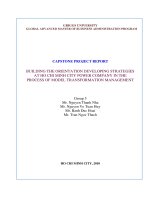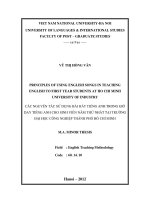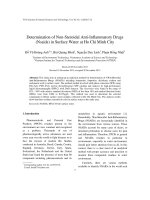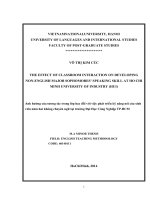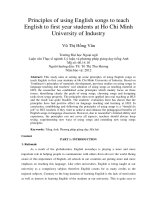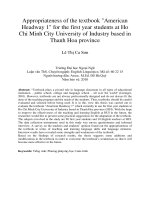the employment of metacognitive reading strategies by tesol postgraduates intakes 9 and 10 at ho chi minh city open university
Bạn đang xem bản rút gọn của tài liệu. Xem và tải ngay bản đầy đủ của tài liệu tại đây (2.2 MB, 122 trang )
MINISTRY OF EDUCATION AND TRAINING
HO CHI MINH CITY OPEN UNIVERSITY
--------------------------------------------------------
THE EMPLOYMENT OF METACOGNITIVE READING
STRATEGIES BY TESOL POSTGRADUATES INTAKES 9 AND
10 AT HO CHI MINH CITY OPEN UNIVERSITY
A THESIS SUBMITTED IN PARTIAL FULFILLMENT OF THE
REQUIREMENTS FOR THE DEGREE OF MASTER OF ARTS (TESOL)
Submitted by NGUYEN THI THU THUY
Supervisor: Assoc. Prof. Dr. PHAM VU PHI HO
HO CHI MINH CITY
April 2018
CHÚ Ý CÁCH SẮP XẾP
1. BÌA TRÊN IN THÊM MỘT TRANG NỮA (BÊN TRONG)
2. TIẾP THEO, LÀ “Ý KIẾN CHO PHÉP BẢO VỆ LUẬN VĂN THẠC SĨ CỦA
GIẢNG VIÊN HƯỚNG DẪN”
3. TIẾP THEO, LÀ “PART II.PDF” (ĐÍNH KÈM)
4. TIẾP THEO, LÀ “PART III.PDF” (ĐÍNH KÈM)
5. TIẾP THEO, LÀ “BIÊN BẢN HỘI ĐỒNG”
6. CUỐI CÙNG, LÀ “BIÊN BẢN CHỈNH SỬA”
DÒNG CHỮ BÊN HÔNG (GÁY LUẬN VĂN):
TESOL9 MASTER OF ARTS IN TESOL NGUYỄN THỊ THU THỦY 2018
STATEMENT OF AUTHORSHIP
I certify that this thesis entitled “The Employment of Metacognitive Reading
Strategies by TESOL Postgraduates Intakes 9 and 10 at Ho Chi Minh City Open
University” is my own work.
Except where reference is made in the text of the thesis, this thesis does not contain
material published elsewhere or extracted in whole or in part from a thesis by which I
have qualified for or been awarded another degree or diploma.
No other person’s work has been used without due acknowledgement in the main text of
the thesis. This thesis has not been submitted for the award of any degree or diploma in
any other tertiary institution.
Ho Chi Minh City, 2018
Nguyen Thi Thu Thuy
i
ACKNOWLEDGEMENTS
This Master of Arts in TESOL thesis is the result of a fruitful collaboration of all the
people who have kindly contributed with an enormous commitment and enthusiasm in
my research. Without the help of those who supported me at all times and in all possible
ways, it would not have been feasible for me to complete my M.A. thesis.
First of all, I am deeply indebted to my supervisor, Assoc. Prof. Dr. Pham Vu Phi Ho
from Van Hien University, whose compassion, encouragement and guidance throughout
the research have helped in the completion of this thesis. I have truly learned from the
excellence of his skills and from his wide experience in research; no words are adequate
to describe the extent of my gratitude.
I am also sincerely grateful to all lecturers of the Open University in Ho Chi Minh City
for providing me with invaluable sources of intellectual knowledge during my study
there. This knowledge was very useful when I conducted this research.
I owe a great debt of gratitude to the anonymous participants who contributed data to this
thesis. Without them the data collection for this study could not properly been carried out.
Last but not least, I would like to express my particular gratitude to my beloved family
for their unconditional love, understanding, encouragement, and financial and spiritual
support over time and distance.
ii
ABSTRACT
Metacognitive reading strategies are significantly important for students at all levels,
including TESOL postgraduates, as it can help them enhance their reading
comprehension. However, if there is any one ignored or less frequently used strategy,
reading comprehension definitely weakens. This study, therefore, aimed at investigating
of the employment of metacognitive reading strategies by the TESOL postgraduates
Intakes 9 and 10 at Ho Chi Minh City Open University as well as their perception
towards the effects of these strategies.
To achieve this purpose, relevant literature on metacognitive reading strategies in both
theory and previous practice was reviewed in the second chapter to shape the theoretical
framework of the study.
Based on this conceptual framework, the study was conducted in the two classes:
TESOL9 and TESOL10 at Ho Chi Minh City Open University. Data collection was fully
carried out during the three weeks of 12th March to 9th April, 2016. Data were collected
through the tools of test, questionnaire and interview for both the two classes, and then
analyzed with version 22.0 of the SPSS software.
The findings of the study indicated that almost all the participants highly recognized the
importance of metacognitive strategies on their reading comprehension. However, in
reality, some strategies were only less frequently used such as paraphrasing, selfquestioning, prior knowledge activating or checking prediction. The notable finding was
found that these less frequently used strategies were employed by the participants who
did not take any C1-level tests.
Based on the research findings, the paper concluded with some pedagogical implications
and a recommendation for further study in the line of research on metacognitive reading
strategies.
iii
TABLE OF CONTENT
Page
Statement of authorship………………………………………………………………………………………………i
Acknowledgements…………………………………………………………………………………………………...ii
Abstract ……………………………………………………………………………………………………………...iii
Table of content ……………………………………………………………………………………………………...iv
List of figures and tables…………………………………………………………………………………………...viii
Chapter 1: INTRODUCTION……………………………………………………………………………………….1
1.1. Rationale for the study…………………………………………………………………………………………….1
1.2. Statement of the problem………………………………………………………………………………………….2
1.3. Research aims……………………………………………………………………………………………………..4
1.4. Research questions…………………………………………………………………………………………….......4
1.5. Importance of the study………………………………………………………………………………………........5
1.6. Scope of the study…………………………………………………………………………………………………5
1.7. Organization of the thesis…………………………………………………………………………………………5
Chapter 2: LITERATURE REVIEW……………………………………………………………………………….7
2.1. Background of reading…………………………………………………………………………………………….7
2.1.1. Definition of reading…………………………………………………………………………………………….7
2.1.2. Approaches of reading…………………………………………………………………………………………..8
2.1.2.1. Bottom-up………………………………………………………………………………………………….......8
2.1.2.2. Top-down approach………………………………………………………………………………………….10
2.1.2.3. Interactive approach…………………………………………………………………………………………11
2.2. Metacognitive reading strategies………………………………………………………………………………...12
2.2.1. Reading strategies……………………………………………………………………………………………...12
2.2.1.1. Definition ……………………………………………………………………………………………………12
2.2.1.2. Classifications ……………………………………………………………………………………………....13
2.2.2. Metacognition …………………………………………………………………………………………………14
2.2.3. Metacognitive reading strategies ……………………………………………………………………………...15
2.2.3.1. Definitions …………………………………………………………………………………………………...15
2.2.3.2. Measurement tools of metacognitive reading strategies…………………………………………………......16
iv
2.3. Overview of language proficiency and use of metacognitive strategies………………………………………...18
2.3.1. Description of reading proficiency…………………………………………………………………………….18
2.3.2. Characteristics of less proficient students in use of reading strategies………………………………………...20
2.4. Relevant previous studies………………………………………………………………………………………...21
2.5. Research gaps………………………………………………………………………………………………….....24
Chapter 3: METHODOLOGY……………………………………………………………………………………..27
3.1. Research site and sampling technique for research participants ………………………………………………...27
3.1.1. Research site…………………………………………………………………………………………………...27
3.1.2. Sampling technique for research participants………………………………………………………………….28
3.2. Research approach ………………………………………………………………………………………………29
3.3. Instruments……………………………………………………………………………………………………….31
3.3.1. Questionnaire………………………………………………………………………………………………......31
3.3.1.1. Rationale for employing questionnaire………………………………………………………………………31
3.3.1.2. Description of the questionnaire…………………………………………………………………………......32
3.3.1.3. Reliability of the questionnaire ……………………………………………………………………………...34
3.3.1.4. Validity of the questionnaire…………………………………………………………………………………35
3.3.2. Reading comprehension test…………………………………………………………………………………...36
3.3.2.1. Rationale for reading comprehension test…………………………………………………………………...36
3.3.2.2. Description of reading comprehension test………………………………………………………………….36
3.3.2.3. Reliability and validity of the interview………………………………………………………………….......37
3.3.3. Interview……………………………………………………………………………………………………….38
3.3.3.1. Rationale for interview……………………………………………………………………………………….38
3.3.3.2. Description of the interview………………………………………………………………………………….38
3.3.3.3. Reliability and validity of the interview………………………………………………………………….......40
3.4. Data collection procedure ……………………………………………………………………………………….40
3.4.1. Collecting data from the questionnaire………………………………………………………………………...40
3.4.2. Collecting data from the reading comprehension test………………………………………………………….41
3.4.3. Collecting data from the interview …………………………………………………………………………….42
3.5. Analytical framework …………………………………………………………………………………………...43
3.5.1. Quantitative analysis for questionnaire ………………………………………………………………………..43
v
3.5.2. Quantitative analysis for reading comprehension test…………………………………………………………43
3.5.3. Qualitative analysis for interview……………………………………………………………………………...44
3.6. Methodological issues……………………………………………………………………………………………45
3.6.1. Ethical considerations……………………………………………………………………………………….....45
3.6.1.1. Consent form…………………………………………………………………………………………………45
3.6.1.2. Anonymity and confidentiality ……………………………………………………………………………....45
3.6.2. Triangulation…………………………………………………………………………………………………...46
Chapter 4: FINDINGS AND DISCUSSION……………………………………………………………………....47
4.1. Findings ……………………………………………………………………………………………………….....47
4.1.1. Findings of the participants’ background information………………………………………………………47
4.1.1.1. From the questionnaire and the test……………………………………………………………………….47
4.1.1.2. From the interview…………………………………………………………………………………………49
4.1.2. Findings of research question 1………………………………………………………………………………..50
4.1.2.1. The use of global reading strategies………………………………………………………………………51
4.1.2.2. The use of problem-solving strategies …………………………………………………………………….53
4.1.2.3. The use of support reading strategies……………………………………………………………………..55
4.1.2.4. The use of overall strategies……………………………………………………………………………….57
4.1.3. Findings of research question 2 ……………………………………………………………………………..59
4.1.3.1. Reading comprehension test results……………………………………………………………………….59
4.1.3.2. Global reading strategies………………………………………………………………………………….61
4.1.3.3. Problem-solving strategies………………………………………………………………………………...64
4.1.3.4. Support reading strategies………………………………………………………………………………...67
4.1.4. Findings of Research question 3…………………………………………………………………………….....70
4.1.4.1. Importance of reading comprehension in TESOL program………………………………………………70
4.1.4.2. Issues of reading act faced by the TESOL postgraduates……………………………………………………71
4.1.4.3. The effect of using metacognitive reading strategies……………………………………………………....75
4.2. Discussion of findings………………………………………………………………………………………….80
4.2.1. Discussion on Research question 1…………………………………………………………………………..80
4.2.2. Discussion on Research question 2…………………………………………………………………………..81
4.2.3. Discussion on Research question 3…………………………………………………………………………..83
vi
CHAPTER 5: CONCLUSION AND RECOMMENDATIONS………………………………………………….85
5.1. Summary of key findings………………………………………………………………………………………...85
5.1.1. Research question 1………………………………………………………………………………………….86
5.1.2. Research question 2………………………………………………………………………………………….87
5.1.3. Research question 3………………………………………………………………………………………….88
5.2. Evaluation of methodology………………………………………………………………………………………89
5.2.1. Strengths………………………………………………………………………………………………………..89
5.2.2. Weaknesses………………………………………………………………………………………………….....89
5.3. Implications and recommendations for students…………………………………………………………………89
5.4. Recommendations for further research…………………………………………………………………………..91
REFERENCES………………………………………………………………………………………………………92
APPENDICES…………………………………………………………………………………………………….....98
Appendix A.1: Adapted version of SORS ……………………………………………………………………...........98
Appendix A.2: Original version of SORS …………………………………………………………………….........101
Appendix B: Reading comprehension test ………………………………………………………………………….102
Appendix C: Interview questions………………………………………………………………………………........111
Appendix D: Consent form (Vietnamese version) ………………………………………………………………….112
vii
LIST OF FIGURES AND TABLES
Figure 3.1: The flowchart of research phases ……………………………………………………………………...30
Table 2.1: Description of the C1 reading requirements…………………………………………………………… 18
Table 3.1: Research questions and data collection instruments………………………………………………….... 31
Table 3.2: Cronbach’s Alpha for each category and all 30 items of the SORS (N=58) …………………………....35
Table 3.3: IELTS reading marking scheme (Academic) …………………………………………………………...44
Table 4.1: Demographic information of the questionnaire respondents and test takers (N=58) ………………...48
Table 4.2: Demographic details of the interviewees (n=6) ………………………………………………………..49
Table 4.3: Global reading strategies employed by TESOL postgraduates ……………………………………….51
Table 4.4: Problem-solving strategies employed by TESOL postgraduates ……………………………………...54
Table 4.5: Support reading strategies employed by TESOL postgraduates ……………………………………...55
Table 4.6: Overall strategies used by TESOL postgraduates ……………………………………………………..57
Table 4.7: Reading comprehension test results……………………………………………………………………60
Table 4.8: Independent-sample t-test results of global reading strategies………………………………………..61
Table 4.9: Independent-sample t-test results of problem-solving strategies……………………………………... 65
Table 4.10: Independent-sample t-test results of support reading strategies …………………………………….67
Table 4.11: Difficulties of academic reading encountered by the TESOL postgraduates………………………...74
Table 4.12: The effects of metacognitive reading strategies reported by the TESOL postgraduates……………..79
viii
Chapter 1
INTRODUCTION
1.1.
Rationale for the study
Numerous studies proved that, reading is an interactive process by which
learners summon different sources such as background knowledge, text schema, lexical
and grammatical awareness, and their personal purposes in order to enhance an
understanding of written material (Karbalaei, 2010). At the same time, reading is of
complexity since many domains (e.g. background knowledge, language proficiency,
and metacognitive knowledge) impact the readers’ reading processes and their
comprehension of texts (Ismail and Tawalbeh, 2015). Besides, Tierney (2005) admits
“learning to read is not only learning to recognize words; it is also learning to make
sense of texts” (p. 51). According to Pressley (2002), reading involves much cognitive
capacity for comprehension.
Moreover, based on Anderson (2003), reading is the interaction of four things
including the reader, the text, “the ability or read at an appropriate rate with adequate
comprehension, and strategic reading” (p. 8), and “the ability of the reader to use a
variety of reading strategies to accomplish a purpose for reading” (p. 8). For this, AdHeisat et al. (2009) posits that awareness of reading strategies helps readers identify
their reading goals and steps used to achieve these goals. Likewise, Cadena (2006)
suggests that
Students are explicitly aware of strategies that could help them to overcome
problems in reading is an accurate way to deal with the learning of reading in
second language. Furthermore, this will facilitate the learning process in other
learning areas and develop students’ basic skills as this enables them to become
successful readers, writers and problem solvers.
1
(p. 97)
Consequently, the aim of research in the area of reading strategies is to explore the
most effective techniques or processes the learners choose to conquest the written texts.
More recently, many studies have focused on conscious awareness of reading
strategies, and strategy training and use in reading comprehension.
Metacognitive reading strategies have become one of the effective ways to
accelerate students’ reading comprehension in the realm of foreign language education.
Early studies on metacognitive reading strategies tended to make lists of strategies and
other features assumed to be really necessary for language students (Oxford, 1994).
According to Karbalaei (2010), “if students are capable of comprehending what they
are reading through a variety of strategies, they will create an interested and selfregulative attitude toward the path of academic achievement” (p. 166). Successful
second/ foreign readers involve into a high level of metacognition, or controlling of
their own thinking during the act of reading. By way of illustration, they make
predictions, check guesses, and administrate their comprehension during working on
meaning from the texts. Succinctly stated, successful language readers are those who
know how to use such reading strategies efficiently.
1.2.
Statement of the problem
When pertaining to the most common problems negatively affecting reading
comprehension, Cabaroglu and Yurdaisik (2008) point out that “unfamiliar texts, lack
of vocabulary, and grammar knowledge, inappropriate level of texts were the common
points that the teachers reported regarding the difficulties students faced in a reading
class” (p. 142). Once again, it is true to confirm that reading is a complex process
where an array of strategies, linguistic knowledge and background knowledge are
concurrently summoned. Similarly, in academic course like TESOL (Teaching English
to Speakers of Other Languages) program, reading is an extremely crucial task to enter
the academic world (Grabe, 1991). In other words, this requires postgraduates to focus
on higher levels of cognitive and metacognitive strategies in their reading practice
2
since utilizing the metacognitive strategies is genuinely effective in students’
achievement and enhances their learning (Imani, et al., 2013). In specific, TESOL
students are considered those who possess a fundamental knowledge about reading
approaches and strategies such as Top-down processing, Bottom-up processing,
scanning, skimming, reading for detail, inferring, deducing meaning from context,
predicting, and so on that they have learned from university curriculum and
experienced numerous types of reading texts. However, English reference materials for
TESOL specialization are often too long (length) and very complicated (content). It is
essential that the TESOL students have to employ effective and proper reading
strategies. A study by Cohen (1998) showed that the contents of the learning situation
may have a strong influence on learners’ own choice of the language learning
strategies. A question is posed whether all TESOL postgraduates have had effective
reading strategies when working on the materials used to course assignments and thesis
as well. The fact proved that skills and strategies for comprehension can be taught,
some students are successful in learning to read English, however others remain at a
low proficiency level throughout their school years. Put it differently, there does exist
the differences of using reading strategies and being aware of these strategies between
the two groups of high and low proficiency level. Furthermore, in fact, it is reported
that there are many different reading strategies; for example, O’Malley and Chamot
(1990) classified learning strategies into 3 subcategories such as Metacognitive
strategies, Cognitive strategies, Socioaffective strategies, and we still remain the
strategies known by other studies. As for the researcher, the priority is given to
employment of metacognitive reading strategies regarded as effective strategies in
many previous studies, and mentioned most by researchers’ discussion.
With all above interest of the study and mentioned issues, together with there
have not been many studies about TESOL postgraduates’ metacognitive reading
strategies, the researcher have made a decision to carry out an investigation into the use
3
of metacognitive reading strategies by TESOL postgraduates Intakes 9 and 10 at Ho
Chi Minh City Open University.
1.3.
Research aims
The aims of the study are (1) to investigate what types of metacognitive reading
strategies are being used by TESOL postgraduates Intakes 9 and 10 at Ho Chi Minh
City Open University; (2) to disclose the difference of using metacognitive reading
strategies between the two groups of high proficient students (within C1 certificate or
other equivalent ones) and less proficient students (without C1 certificate or other
equivalent ones); (3) to probe what difficulties TESOL postgraduates Intakes 9 and 10
encounter in their act of academic reading; from that, some recommendations are made
to help these students at Ho Chi Minh City Open University overcome their current
problems.
1.4.
Research questions
To obtain the established aims above, this study is processed in order to answer
the three research questions as follows:
Research question 1: What types of metacognitive reading strategies are frequently
employed by TESOL postgraduates Intakes 9 and 10 at Ho Chi Minh City Open
University?
Research question 2: Is there any difference in the use of metacognitive strategies in
reading between TESOL postgraduates within and without C1 level (CEFR)?
Research question 3: What perceptions do TESOL postgraduates Intakes 9 and 10
have in terms of their reading problems and the effects of employing metacognitive
reading strategies?
4
1.5.
Importance of the study
This study was conducted in order to help TESOL postgraduates at Ho Chi
Minh City Open University recognize the problem they encounter during their reading
process and improve the students’ reading strategies. Purposefully, it is believed that
findings of this study might provide TESOL postgraduates with new insights and
useful knowledge in relation to applying metacognitive reading strategies in reality.
Moreover, they can understand their own strengths and weaknesses so that they can
adjust their reading strategies to get their goals and good academic achievement in their
TESOL learning program.
1.6.
Scope of the study
This study is conducted for TESOL students Intakes 9 and 10 at Ho Chi Minh
City Open University, so the generations and implication are expected to be only
helpful for TESOL students at Ho Chi Minh City Open University. It is limited to
TESOL students at other universities in Viet Nam and in the world because of learning
environment and level among them. Furthermore, it has also been many other learning
strategies that contribute to learners’ outcomes from the other researchers, but the
researcher only considers the employment of metacognitive reading strategies by
TESOL postgraduates Intakes 9 and 10 at Ho Chi Minh City Open University.
1.7.
Organization of the thesis
This study is divided into five chapters, including
Chapter 1 is the Introduction part which consists of rationale of the study,
problem statement, research aims and questions, significance and scope of the study.
Chapter 2 presents a review of literature and studies relevant to this study. It is
used to examine the theoretical and practical information related to theories of reading
process and strategies. Most importantly, the chapter continues to summarize some
5
related empirical studies. From these studies, some research gaps are provided to
situate the study itself.
Chapter 3 presents the context and participants, data collection instruments and
in which ways these instruments were designed and developed. Also, it presents the
procedure of collecting and analyzing the collected information.
Chapter 4 presents findings from questionnaires and interviews, and an
extensive discussion is also included.
Chapter 5 summarizes the main findings of the study, reveals the limitations
and gives suggestions for further research.
6
Chapter 2
LITERATURE REVIEW
Chapter introduction
In this chapter, the related literature will be reviewed and analyzed with regard
to relevant concepts of (1) definitions of reading and some typical approaches of
reading act; (2) reading strategies and metacognition, which literally catalyze the theme
of metacognitive reading strategies; (3) measurement tools for assessing the students’
conscious awareness of reading strategies; (4) the relationship between language
proficiency and the use of metacognitive reading strategies. As an important part, some
previous studies will be summarized and critically evaluated, which help the study
situate itself in this field.
2.1.
Background of reading
Reading is one of the two receptive skills that are very important to the
academic success of language learning and teaching. In this section, the study provides
a precise picture of reading skill or comprehension synthetically drawn by its various
definitions, and approaches as well.
2.1.1. Definition of reading
According to Harmer (2001), reading along with listening is a receptive skill
which means that readers need to decode the meaning from what they see. In more
specific, Goodman (1994) defines reading as complicated processes to build up
meaning for readers through their interactive process with the text. Many researchers
such as Anastasiou and Griva (2009) as an example reckon that reading is a complex
process involving includes several abilities such as perceptual, psycholinguistic, and
cognitive abilities. It is universally agreed that the three key elements of reading
process are accuracy (i.e. phonological and orthographic processing), fluency (i.e.
time), and comprehension. In other words, reading does not merely mean
7
understanding the text, but it comprises of word reading and language comprehension
(Gough and Tunmer, 1986). Word reading relates to the ability to decode the words out
of context while language comprehension relates to the ability to understand words or
sentences as a whole in context of the text. The two components of reading
comprehension supplement each other. That is to say students cannot understand the
text if they are not adequately provided with vocabulary. On the other hand, the fact
that students with the ability of reading words out of context does not mean that they
can make sense of those words in context of a particular text.
In brief, reading is a complex cognitive ability requiring the capacity to integrate
text information with the prior knowledge of the reader and resulting in the elaboration
of mental representation (Anderson, 2003; Meneghetti, Carretti, and Beni, 2006). Thus,
reading comprehension is an interactive process between a reader and a text
(Rumelhart, 1994). During this interaction, the readers exert different knowledge and
skills including language skills, cognitive resources and world knowledge.
2.1.2. Approaches of reading
It is noted that in an attempt to understand the definitions of speaking skill and
comprehension, several researchers have proceeded by analyzing it in terms of a set of
approaches to reading process which will be presented as below. Many researchers in
the field of reading have classified the models of reading into three categories such as
bottom-up, top-down, and interactive approaches. These approaches describe what
happens when readers look at the text, and also what complementary ways of
processing a text are. Readers use them with unconscious way, or adopt them as
conscious processes during reading a text.
2.1.2.1. Bottom-up
Bottom-up processing is considered as a process which is related to language
structures. To put it another way, it concentrates on individual words, phrases or
cohesive devices and gets understanding by associating detailed elements together to
8
create a whole. According to Adams (1990), when the words of the written text are
identified, they immediately recognize the words to which they belong. The readers
grasp syntactic and semantic structures once they capture words. Overall,
comprehension level in this model is catered upwards since the analytical product of
low level is the coming elements of higher levels. This is called bottom-up processing.
In the bottom-up approach, the role of word knowledge is requisite for lexical
recognition which is regarded as its strength. On the other hand, bottom-up processing
is also hierarchical, through identifying letters and words and constructing a meaning
for a written text from the smallest textual units at the “bottom” (i.e. letters and words)
to bigger units at the “top” (i.e. phrase, clause, and sentential linkages). This means that
we need to know all letters of a word to access its meaning, and all the words in a
clause or a sentence to construct its whole meaning. Therefore, the knowledge of
vocabulary is a fundamental advantage for this process.
Apart from that, an important disadvantage of this model is shortage of
feedback, in that no mechanism is given to permit for processing stages which happen
later in the system to affect the process which takes place earlier in the system. Due to
the lack of feedback in the early bottom-up model, it is challenging to explain
sentence-context effects and the contribution of prior knowledge of the text theme as
facilitating changes in word recognition and comprehension (Carrell, Devine and
Eskey, 1998). Thus, the combination of readers’ past experiences and language
knowledge is not considered to make contribution to reading comprehension.
In brief, the bottom-up processing is a model which focuses on word
recognition. Therefore, the readers can only achieve better reading comprehension by
applying the recognition of words, phrases and finally sentences. In contrast to this
advantage, the importance of relating background knowledge to sociocultural meaning
is not considered in second language reading comprehension of this process viewed as
its weakness.
9
2.1.2.2. Top-down approach
Top-down processing is a model by which the readers get a general view of the
reading passage and absorb the overall picture. Carell, Devine and Eskey (1988) found
that in top-down processing, since the reader is only checking the textual information
so as to verify hypothesis and prediction, reading is reckoned as being conceptually
provoked by the higher order stages. In specific, the readers base on their background
knowledge and expectations to reconstruct the meaning of the text. One important
advantage of this process is language knowledge, world knowledge and personal
experiences are expressed in top-down influences reading comprehension. As for the
top-down process, Anderson (2003) stated that top-down processes emphasize that
meaning is located inside the readers. Readers activate their background knowledge
and make predictions before reading the text to find out information for their
predictions made in advance. Meanwhile, Schramm (2008) based on the amount of
pre-knowledge used by students to make the distinction between top-down and bottomup processes. As students need to use their background knowledge in both top-down
and bottom-up processes, there is an interaction among the two processes. Meanwhile,
Wallace (1992) stated that the top-down processes in reading mainly rest on students’
bringing their background knowledge to boost their reading performance. As a result,
in the readers become more active participants in reading process.
However, one problem posed for top-down model is that for many texts, the
readers usually possess little background knowledge of the given topic and therefore it
is hard to manipulate predictions. Besides, a more serious problem is that even in the
case that a skilled reader can manipulate the predictions; the amount of time necessary
for this may be much more than the amount of the time the skilled reader utilizes
simply to recognize the words. This means that in some cases, it is for more difficult
for readers to make predictions than recognize words in a text.
10
In summary, the top-down model of reading focuses on meaning. Cohen (1990)
explains that the readers should not recognize all letters, words and sentences in the
written text; instead of that, they only need to identify key words and phrases to
comprehend the meaning of the text. It is started with predictions and then some
attempt to check these predictions by working down the written texts. Thus, it is more
useful for readers to make a combination between top-down and bottom-up processing
to achieve the best in reading comprehension.
2.1.2.3. Interactive approach
From the problems emerging in bottom-up and top-down processing, many
researchers found that interactive models appears to provide a better result of reading
performance than heavily rely on bottom-up or top-down model. The interactive model
involves employing both top-down and bottom-up skills to construct the meaning of
the text. It highlights that reading is the interaction between readers and texts.
According to this approach, reading is attached to the perceptions of graphic cues as
soon as these are recognized as familiar, both linguistic schemata and world knowledge
are brought into play (Grabe, 1991). Furthermore, in this model, texts cannot be
considered either generally easy or difficult on the basis of linguistic features; texts
become easier if they correspond with the reader’s prior knowledge (Clark and
Silberstein, 1979). Thus, failure in reading comprehension can occur if there is a
breakdown in compatibility between bottom-up and top-down processes.
In short, the interactive approach emphasizes the application to the interaction
of bottom-up and top-down processes to get successful reading, it is necessary for
readers to have an appropriate balance between these approaches and an important
aspect of interactive approach is that bottom-up and top-down processes could occur at
all level simultaneously. In other words, an inappropriate balance between bottom-up
and top-down models leads to failure in reading comprehension, thereby producing
unsuccessful readers. To give an example, a student who has good word-recognition
11
skills, but poor inference skills will still face comprehensive problems as this reader
will not be able to fill in the missing links in a text.
2.2.
Metacognitive reading strategies
In this section, the study will present a general picture of metacognitive reading
strategies. To make it clearer, the researcher mentions the definition and classification
of reading strategies at first, then metacognition, and finally issues and measurements
of metacognitive reading strategies.
2.2.1. Reading strategies
2.2.1.1. Definition
Numerous definitions of reading strategies have been extensively found in the
relevant literature. As what Cohen (1990) defines, reading strategies are “mental
processes that readers consciously choose to use in accomplishing reading tasks” (p.
83). In the same line, they are “the mental operations involved when readers approach
a text effectively to make sense of what they read […] Good readers apply more
strategies more frequently and more effectively than poor readers” (Pani, 2004, p. 67).
Additionally, according to Block (1986), it is emphasized that reading strategies
indicate how readers perceive a task, what textual clues they will use, how they
construct meaning of what they read, and what strategies they use to overcome reading
problems. But in the most common, Mokhtari and Sheorey (2002) define reading
strategies based on three aspects of (1) intentionally, carefully planned techniques by
which readers manage their reading; (2) actions and procedures that the readers use
during they directly work with a text; (3) basic support aimed to assist readers in
reading comprehension. The impact of these strategies on reading is viewed as a pillar
in any act of reading. By anyway, “reading comprehension is attributed to developing
suitable, efficient comprehension strategies” (Brown, 2001, p. 306).
12
2.2.1.2. Classifications
In the field of reading strategies, there have been some studies which enumerate
different categories of reading strategies.
First of all, Oxford (1990) classifies listening learning strategies into the two
main classifications including direct strategies and indirect strategies. This division
depends on the extent to which they relate to language. Remarkably, these two
strategies are not separate or contradictory but closely interdependent. Direct strategies,
as the name implies, are directly related to the intellectual processing of language such
as memorization of vocabulary, or form recognition. They are used to deal with the
new information and work with language in different tasks and situations. On the other
hand, indirect strategies have no direct relevance to language as direct strategies. Direct
strategies consist of (1) memory strategies, (2) cognitive strategies, and (3)
compensation strategies; while indirect strategies include (1) metacognitive strategies,
(2) affective strategies and (3) social strategies.
Based on the model of interactive approach, Carell (1998) categorizes reading
strategies into two types: cognitive and metacognitive strategies. Cognitive strategies
are directions by which learners work with and manipulate the task materials
themselves, leading to task completion. Samples of cognitive strategies include
prediction on prior knowledge, analysis of text organization, summary, taking notes,
etc. These strategies are identified as important cognitive strategies related to academic
performance in the classrooms because they are applied to from simple to complex
tasks that require understanding of information; whereas, metacognitive strategies
involve thinking about the learning process, being aware and controlling of planning
for learning, monitoring the learning task, summarizing and evaluating how well it has
been ended. In the same line, Mokhtari and Sheorey (2002) generate another
classification scheme involving metacognition to classify the reading strategies within
three categories, that is, (1) global strategy (e.g. having reading purpose in mind); (2)
13
problem-solving strategy (e.g. modify reading speed, rereading); (3) support strategy
(e.g. using dictionary, taking notes, etc.).
2.2.2. Metacognition
Metacognition refers to an awareness of cognitive processes, that is, “thinking
about thinking”. In other words, students who use metacognitive strategies are aware of
their thinking processes during studying. Metacognition, based on Flavell (1976), is
defined as “one’s knowledge concerning one’s own cognitive processes and outcomes
or anything related to them” (p. 232). Flavell further explains that metacognition is “the
active monitoring and consequent regulation and orchestration of these processes in
relation to the cognitive objects or data on which they bear, usually in the service of
some concrete goal or objective” (p. 238). In other words, metacognition can be
defined as the development of students’ mental abilities.
Flavell’s (1979) model of metacognition is the foundation for research in the
field of metacognition today when discussing about the parts of metacognition.
According to his model, there are four categories: (1) metacognitive knowledge, (2)
metacognitive experiences, (3) goals/ tasks, and (4) actions/ strategies. He exemplified
that people manage their cognitive process by using components described in these
four categories. In the same vein, Kuhn (2000) refers metacognition to two aspects,
namely the students’ self-awareness of a knowledge base in which information is
stored about how, when, and where to use various cognitive strategies and their selfawareness of and access to strategies that direct learning. This awareness of strategies
is deemed to be developmental and lies on a continuum.
Pintrich, Wolters and Baxter (2000) supplement that there are three main
aspects of metacognition: metacognitive knowledge, metacognitive monitoring, self–
regulation and control. In brief, metacognition talks about a level of thinking that
involves active control over the process of thinking during a learning activity such as
English reading. These scholars suggest that the learner develops perceptions of the
14
task demands, engages in metacognitive monitoring, selects and implements cognitive
strategies that are appropriate for the task demands, and evaluates task performance
while reflecting on the effectiveness of the cognitive strategies.
Literature on metacognition has unraveled that less proficient readers do not
capture the purpose of reading and only pertain to employ word-by-word strategy. Put
simply, they lack metacognitive ability, and are not aware of the problems that emerge
during reading and do not know how to monitor their reading process. Moreover, less
proficient readers are less competent in planning, monitoring and controlling their
understanding of texts, or deficient in summoning their own metacognitive skills.
Conversely, good readers are those who actively utilize their own metacognition to
follow up their reading purposes, use different reading strategies to facilitate their
reading comprehension, and so on (Lau, 2006). It goes without saying that
metacognition plays a pivotal role in English reading comprehension, and the readers
need to activate their own metacognitive abilities to monitor what are being read.
2.2.3. Metacognitive reading strategies
2.2.3.1. Definitions
Based upon Brown (1994), metacognitive reading strategies include “checking
an outcome of any attempt to solve a problem, plan one’s text move, monitoring the
effectiveness of any attempted action, testing, revising and evaluating one’s strategies
for reading” (p. 115). It is generally accepted that metacognitive reading strategies are
classified into three groups of [1] planning (pre-reading), [2] monitoring (duringreading), and [3] evaluating (post-reading) strategies, and each group has a different set
of strategies that require readers’ metacognitive awareness (Skehan, 1989).
Planning strategies are used before reading; activating learners’ background
knowledge to get prepared for reading is an example of planning strategies (Israel,
2007). Also, previewing a title, picture, illustration, heading, or subheading can help
readers grasp the overview of the text. Readers may also preview the general
15




